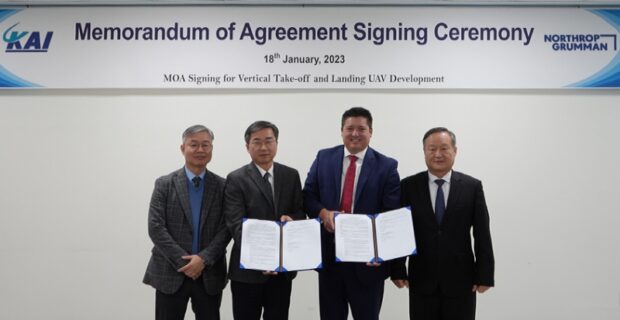announced on January 19th that it had signed a memorandum of agreement (MOA) with Northrop Grumman for technical cooperation in the business of vertical take-off and landing drones at its headquarters in Sacheon on the 18th.
The signing ceremony was attended by key officials, including KAI Ji-Hong Kim, Director of the Future Convergence Technology Institute, Richard J. Sullivan, Vice President of NG, and Ha Dong-Jin, Head of Korea Branch.
The key to this MOU is mutual cooperation for the domestic development of vertical take-off and landing UAVs that can be mounted on and operated by naval destroyers.
Vertical take-off and landing UAVs for maritime missions are expected to be used for territorial defense missions such as constant surveillance, reconnaissance, and target acquisition in vast sea areas and operation areas by being mounted on ships such as navy destroyers and coast guard patrol ships.
KAI expects to greatly reduce development risk and required period based on NG’s proven development experience.
NG is a developer of the MQ-8 Fire Scout vertical take-off and landing UAV currently operated by the US Navy, and has vertical take-off and landing UAV development technology optimized for maritime missions.
KAI Future Convergence Technology Director Kim Ji-hong said,
“We are concentrating on developing next-generation UAV technology with the goal of leading the future unmanned era.” said.
NG Vice President Richard Sullivan said,
“Northrop Grumman has consistently led the market in the field of advanced unmanned aerial vehicles, and we expect that cooperation with KAI will dramatically improve the ROK Navy’s maritime surveillance and reconnaissance capabilities.”
Meanwhile, KAI has secured various UAV technologies through its own preceding research, starting with the development of the RQ-101, a corps-level UAV successfully deployed for the first time in Korea, and is currently developing the next corps-level UAV.
Through its own prior research and government R&D, it has introduced various UAVs, such as a scaled-down unmanned fighter model, a long-endurance multipurpose UAV, and a tiltrotor-type technology demonstration machine.
Going forward, KAI plans to internalize future cutting-edge technologies such as AI and big data, and expand its scope to new businesses such as future manned and unmanned complex systems to prepare for the era of advanced unmanned aerial vehicles.

